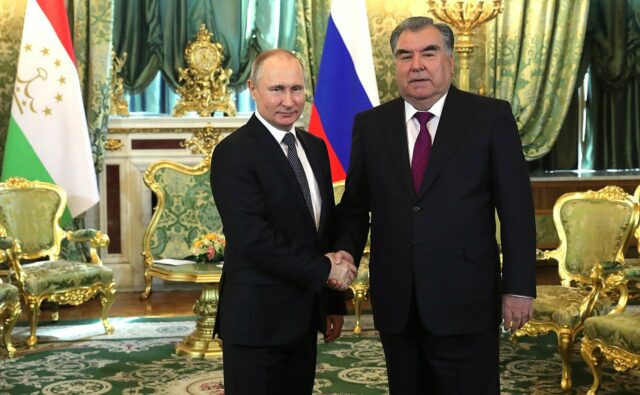Enhancing Regional Security: Russia-Tajikistan Joint Anti-Terrorism Exercises

Geopolitical Report ISSN 2785-2598 Volume 41 Issue 15
SpecialEurasia OSINT Unit
Executive Summary
Russia and Tajikistan are currently engaged in joint counterterrorism exercises, which have become even more crucial because of the rise in terrorist activities in Afghanistan. This partnership between Moscow and Dushanbe highlights their commitment to enhancing military and defence cooperation.
Furthermore, the fact that Moscow has a military presence in Tajikistan and works closely with Dushanbe to combat terrorism underscores the Kremlin’s plan to enhance its presence and influence in Central Asia, taking advantage of the terrorist threat emanating from neighbouring Afghanistan.
Background Information
On April 15th, 2024, Russia and Tajikistan have begun joint anti-terrorism exercises in the Khatlon region, as reported by the Russian Ministry of Defence. The exercises involve units from the 201st Russian Military Base (RVB) and aim to enhance capabilities in countering terrorist threats and defending borders. The exercises, set in mountainous terrain, will continue until April 18th, 2024.
Since the withdrawal of U.S. troops from Afghanistan in August 2021 and the subsequent rise of the Taliban, Russia has intensified its military and defence cooperation with Tajikistan.
The escalating terrorist activities in the Afghan territory motivate this collaboration, notably by groups such as the Islamic State Wilayat Khurasan (IS-Khurasan). Tajikistan, sharing a border with Afghanistan, faces the direct impact of these threats.
Countering terrorism is also important considering that recently IS-Khurasan released its first issue of the Voice of Khurasan in the Tajik language, addressing Dushanbe’s government and depicting Tajik president Emomali Rahmon as an apostate. The publication, released online after the terrorist attack in Moscow, confirmed the terrorist groups’ strategy to recruit among the young generations in Central Asia, especially in Tajikistan, a country which has experienced an increasing strict regime.
Moreover, the recent terrorist attack at the Crocus City Hall in Moscow, conducted by Tajik citizens, underscores the immediate necessity for increased collaboration between Moscow and Dushanbe in combating terrorism.
In addition to other challenges, Tajikistan is currently grappling with the rise of Tehrik-e-Taliban Tajikistan, a group that came into existence in July 2022. Operating in northern Afghanistan, this group seeks to unite Tajik nationals under the Taliban banner and overthrow the Tajik government in Dushanbe.
Read also | Analysis of The Voice of Khurasan First Issue in the Tajik Language |
Geopolitical Scenario
The joint anti-terrorism exercises between Russia and Tajikistan show that the two countries are working together strategically to address the security concerns they have in common.
Russia views Central Asia, including Tajikistan, as within its sphere of influence and seeks to bolster its presence in the region amid the developing security landscape following the U.S. withdrawal from Afghanistan.
Tajikistan, in turn, relies on Russian support to counter the growing terrorist threats emanating from Afghanistan and to safeguard its borders.
Moreover, the exercises serve as a demonstration of Russia’s commitment to maintaining stability in the region and preventing the spread of extremism and terrorism beyond Afghanistan’s borders.
By actively engaging in military cooperation with Tajikistan, Russia aims to consolidate its position as a key security partner in Central Asia and enhance its influence in the broader Eurasian region.
Risk Assessment
Despite the joint exercises being a proactive measure to address terrorism threats, there are still several risks and challenges that need to be considered. The ongoing instability in Afghanistan, exacerbated by the Taliban’s resurgence and the presence of various terrorist groups, poses a persistent threat to regional security. The potential for spillover effects, including cross-border attacks and the infiltration of extremist elements into Tajikistan, remains a significant concern.
The presence of non-state actors and competition among regional powers in Central Asia’s complex geopolitical dynamics have the potential to hinder efforts in effectively countering terrorism.
Moreover, the longstanding frictions between Tajikistan and Kyrgyzstan, particularly surrounding their contested borders, contribute an extra level of intricacy to the security challenges in the region.
In conclusion, while the joint exercises between Russia and Tajikistan reflect an active approach to addressing shared security challenges, sustained cooperation and coordination will be essential to effectively mitigate the risks posed by terrorism and instability in the region.
Read also | Terrorist Attack in Russia and Islamic State Wilayat Khurasan’s Jihadist Propaganda |
For further information, reports, and risk assessments on the Tajik-Afghan border and Russian involvement in Central Asia, contact us at info@specialeurasia.com.
